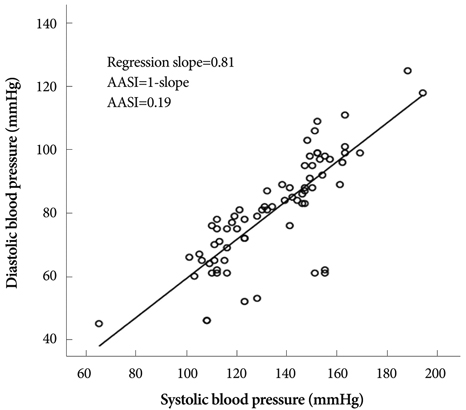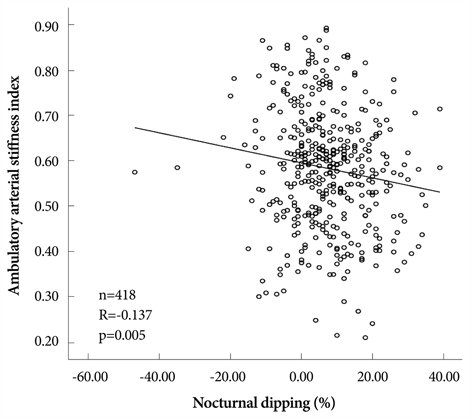Korean Circ J.
2011 May;41(5):235-240. 10.4070/kcj.2011.41.5.235.
The Relationship Between Ambulatory Arterial Stiffness Index and Blood Pressure Variability in Hypertensive Patients
- Affiliations
-
- 1Division of Cardiology, Department of Internal Medicine, Hanyang University College of Medicine, Seoul, Korea. jhs2003@hanyang.ac.kr
- 2Department of Preventive Medicine, Dong-A University College of Medicine, Busan, Korea.
- KMID: 2297929
- DOI: http://doi.org/10.4070/kcj.2011.41.5.235
Abstract
- BACKGROUND AND OBJECTIVES
Ambulatory arterial stiffness index (AASI) is well known as a predictor of cardiovascular mortality in hypertensive patients. Mathematically, AASI reflect the standard deviation (SD) of blood pressure (BP) variation. AASI is measured higher levels in non-dipper than dipper. Thus, AASI has a possibility of not only reflecting arterial stiffness but also BP variability and/or autonomic nervous dysfunction.
SUBJECTS AND METHODS
Consecutive data from 418 untreated hypertensive patients were analyzed retrospectively. We examined the association between the 24-hour ambulatory BP monitoring (ABPM) parameters and AASI.
RESULTS
AASI had a simple correlation with age (R=0.189, p<0.001), relative wall thickness (RWT) (R=0.115, p=0.019), left ventricular mass index (LVMI) (R=0.192, p<0.001), average systolic BP (SBP) (R=0.232, p<0.001), average pulse pressure (PP) (R=0.363, p<0.001), SD of diastolic BP (DBP) (R=-0.352, p<0.001), SD of PP (R=0.330, p<0.001), SD of heart rate (HR) (R=-0.268, p<0.001), and nocturnal dipping (R=-0.137, p=0.005). In multiple linear regression analysis model including clinical parameters and 24 hour-ABPM parameters, independent predictors of AASI were SD of PP (beta=1.246, p<0.001), SD of DBP (beta=-1.067, p<0.001), SD of SBP (beta=-0.197, p<0.001), and non-dipper (beta=0.054, p=0.033).
CONCLUSION
AASI is closely correlated with BP variability. The result of this study shows that AASI is not only a parameter for arterial stiffness, but also a parameter for BP variability.
MeSH Terms
Figure
Reference
-
1. Li Y, Wang JG, Dolan E, et al. Ambulatory arterial stiffness index derived from 24-hour ambulatory blood pressure monitoring. Hypertension. 2006. 47:359–364.2. Dolan E, Thijs L, Li Y, et al. Ambulatory arterial stiffness index as a predictor of cardiovascular mortality in the Dublin Outcome Study. Hypertension. 2006. 47:365–370.3. Dolan E, Li Y, Thijs L, et al. Ambulatory arterial stiffness index: rationale and methodology. Blood Press Monit. 2006. 11:103–105.4. Kikuya M, Ohkubo T, Metoki H, et al. Day-by-day variability of blood pressure and heart rate at home as a novel predictor of prognosis: the Ohasama study. Hypertension. 2008. 52:1045–1050.5. Mancia G, Parati G, Hennig M, et al. Relation between blood pressure variability and carotid artery damage in hypertension: baseline data from the European Lacidipine Study on Atherosclerosis (ELSA). J Hypertens. 2001. 19:1981–1989.6. Kikuya M, Hozawa A, Ohokubo T, et al. Prognostic significance of blood pressure and heart rate variabilities: the Ohasama study. Hypertension. 2000. 36:901–906.7. Frattola A, Parati G, Cuspidi C, Albini F, Mancia G. Prognostic value of 24-hour blood pressure variability. J Hypertens. 1993. 11:1133–1137.8. Schillaci G, Parati G, Pirro M, et al. Ambulatory arterial stiffness index is not a specific marker of reduced arterial compliance. Hypertension. 2007. 49:986–991.9. Baumann M, Dan L, Nurnberger J, Heemann U, Witzke O. Association of ambulatory arterial stiffness index and brachial pulse pressure is restricted to dippers. J Hypertens. 2008. 26:210–214.10. Darne B, Girerd X, Safar M, Cambien F, Guize L. Pulsatile versus steady component of blood pressure: a cross-sectional analysis and a prospective analysis on cardiovascular mortality. Hypertension. 1989. 13:392–400.11. Girerd X, Laurent S, Pannier B, Asmar R, Safar M. Arterial distensibility and left ventricular hypertrophy in patients with sustained essential hypertension. Am Heart J. 1991. 122:1210–1214.12. Rhee B, Park J, Kim H, et al. Increased aortic stiffness is associated with increased left ventricular mass and diastolic dysfunction. Korean Circ J. 2005. 35:525–532.13. Shin J, Lee J, Lim H, Lee B, Kim M, Choi B. The relationship between the pulse wave velocity (PWV) and the left ventricular geometry: a community-based cross-sectional study. Korean Circ J. 2005. 35:683–689.14. Roman MJ, Ganau A, Saba PS, Pini R, Pickering TG, Devereux RB. Impact of arterial stiffening on left ventricular structure. Hypertension. 2000. 36:489–494.15. Devereux RB, Alonso DR, Lutas EM, et al. Echocardiographic assessment of left ventricular hypertrophy: comparison to necropsy findings. Am J Cardiol. 1986. 57:450–458.16. Daniels SR, Kimball TR, Morrison JA, Khoury P, Meyer RA. Indexing left ventricular mass to account for differences in body size in children and adolescents without cardiovascular disease. Am J Cardiol. 1995. 76:699–701.17. de Simone G, Daniels SR, Devereux RB, et al. Left ventricular mass and body size in normotensive children and adults: assessment of allometric relations and impact of overweight. J Am Coll Cardiol. 1992. 20:1251–1260.18. Muscholl MW, Hense HW, Brockel U, Doring A, Riegger GA, Schunkert H. Changes in left ventricular structure and function in patients with white coat hypertension: cross sectional survey. BMJ. 1998. 317:565–570.19. Abate G, D'Andrea L, Battestini M, Zito M, Di Iorio A. Autonomic nervous activity in elderly dipper and non-dipper patients with essential hypertension. Aging (Milano). 1997. 9:408–414.20. Kohara K, Nishida W, Maguchi M, Hiwada K. Autonomic nervous function in non-dipper essential hypertensive subjects: evaluation by power spectral analysis of heart rate variability. Hypertension. 1995. 26:808–814.21. Park JS, Park CG, Park MY, et al. Relation of blood pressure components to left ventricular hypertrophy and coronary heart disease with aging. Korean Circ J. 2004. 34:142–150.22. Khattar RS, Acharya DU, Kinsey C, Senior R, Lahiri A. Longitudinal association of ambulatory pulse pressure with left ventricular mass and vascular hypertrophy in essential hypertension. J Hypertens. 1997. 15:737–743.23. Pannier B, Brunel P, el Aroussy W, Lacolley P, Safar ME. Pulse pressure and echocardiographic findings in essential hypertension. J Hypertens. 1989. 7:127–132.24. Grossman W, Jones D, McLaurin LP. Wall stress and patterns of hypertrophy in the human left ventricle. J Clin Invest. 1975. 56:56–64.25. Hansen TW, Staessen JA, Torp-Pedersen C, et al. Ambulatory arterial stiffness index predicts stroke in a general population. J Hypertens. 2006. 24:2247–2253.26. Dart AM, Kingwell BA. Pulse pressure: a review of mechanisms and clinical relevance. J Am Coll Cardiol. 2001. 37:975–984.27. Akselrod S, Amitayt Y, Lang RM, Mor-Avi V, Keselbrener L. Spectral analysis of left ventricular area variability as a tool to improve the understanding of cardiac autonomic control. Physiol Meas. 2000. 21:319–331.28. Gkaliagkousi E, Douma S. The pathogenesis of arterial stiffness and its prognostic value in essential hypertension and cardiovascular diseases. Hippokratia. 2009. 13:70–75.
- Full Text Links
- Actions
-
Cited
- CITED
-
- Close
- Share
- Similar articles
-
- Arterial stiffness and hypertension
- Hypertension and Vascular Aging
- Resting Heart Rate and Aortic Stiffness in Normotensive Adults
- Interrlationship between Left Ventricular Mass and Diurnal Variations of Blood Pressure in Patients with Esssntial Hypertension
- Effect of Obesity on Blood Pressure and Arterial Stiffness in Middle-Aged Korean Women



